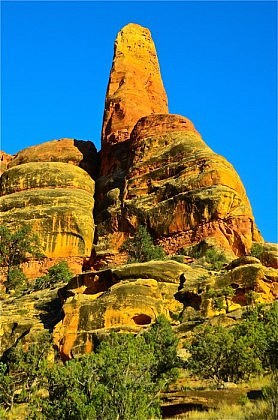First and foremost, do not handle rattlesnakes! What seems like common sense obviously isn’t, judging by the behavior of some young males (see previous blog post for more on this) who skew the statistics upward in the annual tally of snakebite victims in the United States. In the previous post, I discussed the Darwinian implications of mixing young male humans with rattlesnakes and beer.
Second, don’t be paranoid, but do be vigilant. Be aware of weather conditions. Rattlesnakes are cold blooded reptiles, so in the morning after a cold night, expect them to be out soaking up the sun like it’s spring break at Fort Lauderdale (Unlike humans, though, snakes don’t get skin cancer). On a hot afternoon, expect them anywhere, but especially in the shade, behind rocks or in the brush. And you can even find them in the water! Which leads me to rule number three: Don’t step where you cannot see. Sure, you’re in the desert and much of the ground is open with sparse vegetation. But canyon bottoms along desert streams can be jungle-like, so sometimes you need to seriously concentrate on where you step.
Rule number four is also common sense. We upright hominids love to climb around on rocks (be careful!), especially in the colorful sandstone wilds of Utah’s canyon country. Simply put, do not reach and put your hands where you cannot see! A disproportionate number of snakebites occur on the hands and arms. So look before you reach!
By the way, in the United States fatal snakebites are extremely rare. Small children and the elderly are at particular risk of succumbing to snake venom. But overall death-rates are under 2% (which is little consolation if you happen to be in that 2%). More often than not, though it won’t kill you, a snakebite will earn you a new nickname, such as “lefty” or “goofy” or “six fingers”. It may not kill you, but it sure can mess you up. So be alert. Don’t be paranoid, be observant. Leave the snake alone and it will in all likelihood leave you alone. Wondering through the desert on a guided backpack trip is a wonderful way to spend a week — and with just a bit of care, it’s also a remarkably safe way to enrich your life in a beautiful wilderness environment.



